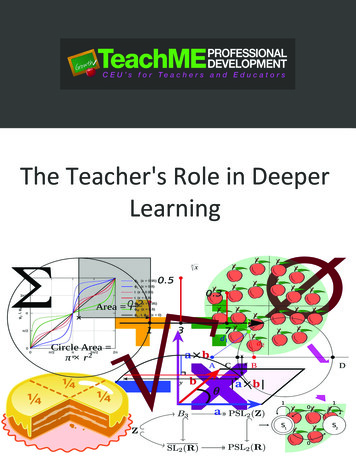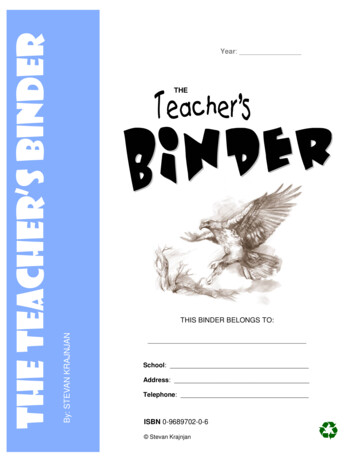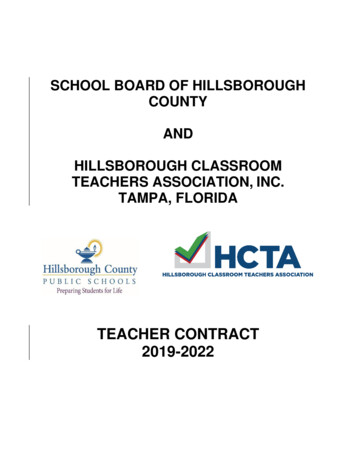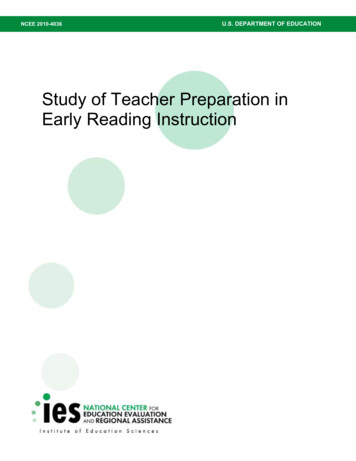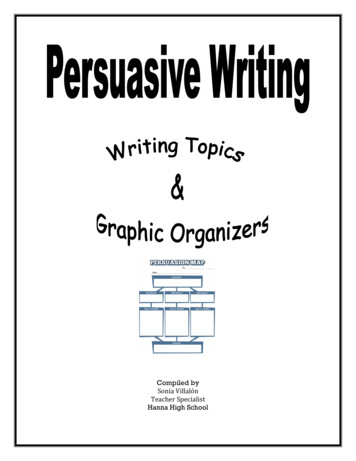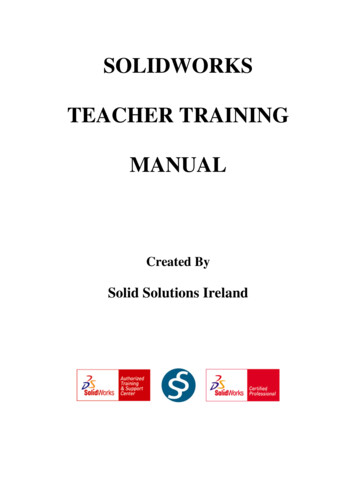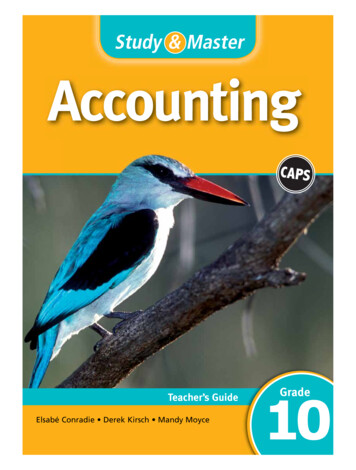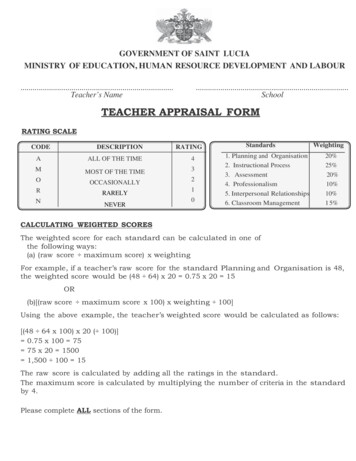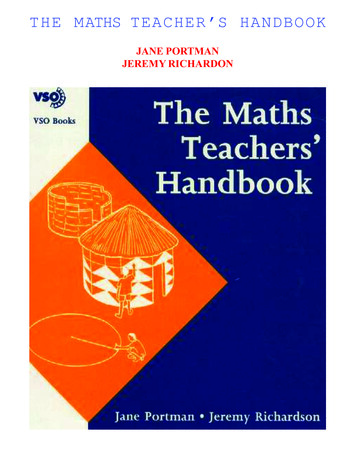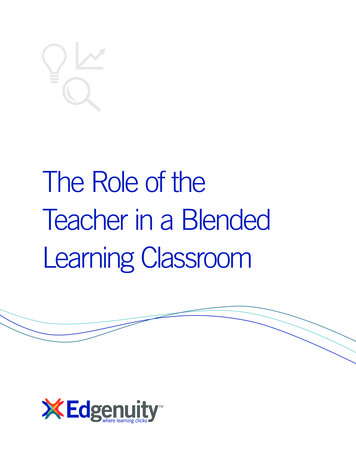
Transcription
The Role of theTeacher in a BlendedLearning Classroomwhere learning clicks
This document outlines 10 research-basedsteps teachers can take to maximize studentlearning in blended learning courses.1. Understand the technology students will be using 42. Create a data-driven culture 73. Set high expectations 104. Carefully plan offline activities 135. Promote deeper learning and check for understanding 166. Teach students metacognitive and self-regulation skills 197. Make learning relevant and engaging 228. Monitor data 259. Provide positive feedback to students and celebrate success 2810. Encourage online discussion 312 Edgenuity Inc.
IntroductionAmerican schools are in an unprecedented time of change. Educators are working harder than ever to tackle some of the most pressingissues that have ever faced our students—higher standards, a difficult economy, and a fast-paced world.As part of their new and challenging work, teachers nationwide are embracing blended learning models—a formal education program inwhich students learn, in part, through online delivery of content and, in part, in a brick-and-mortar instructional environment.Online and blended learning instructional models are among the fastest growing trends in education today. In 2002, for example, therewere approximately 222,000 high school students enrolled in online learning. In 2010, nearly 1.4 million high school students wereengaged in some kind of online or blended learning program.1 The popularity of blended learning is no surprise; it offers an alternativeway to engage students with a remarkable array of learning experiences, particularly for students who struggle in traditional classrooms.It also gives teachers an opportunity to facilitate learning in innovative ways. What’s more, research supports the conclusion thatstudents can learn just as well from blended learning as from traditional classes.2But the presence of technology alone is no guarantee that students will succeed. Strong, effective blended learning doesn’t justhappen. It requires the work of thoughtful, engaged teachers who leverage the best of technology and face-to-face instruction toaddress the unique learning styles of their students.Across the country, teachers are changing students’ lives with the help of technology in blended learning classrooms. Teachers areknowledge facilitators, mentors, and coaches in these environments. They assess, analyze, and synthesize student work and data todevelop unique learning plans for each student, while monitoring and working with small groups and entire classes. They identifylearning opportunities for students, engaging them in complex activities and holding them to ever higher expectations.3 In short,these educators are “becoming true educational designers,”4 harnessing the power of these online tools to make their curriculumresonate with students.When educational technology is combined with strong, skilled teachers, it makes for a classroom where teachers are able to buildpowerful relationships and direct their attention where students need them most. Teachers can spend their time communicating,connecting, facilitating, providing feedback, and ultimately helping all students learn.Great teachers, equipped with great online learning tools, are changing the way students think about school, about their education,and about their lives.They’re making learning effective, efficient, empowering, and engaging.They’re making learning click. 3
Understand the Technology Students Will Be UsingHow It Clicks1We’re raising technology-savvy students in a technology-filled world, and teachers know technology is essential to keep kids excitedabout learning. This excitement about digital tools is part of why blended learning classrooms are so appealing to students . . . but it’snot the only part.Any great teacher knows that a tailored curriculum—one thatmatches the learning style, pace, and interests of a student—isessential to ensuring student achievement. Technology facilitatesthis kind of curriculum design, helping teachers track studentprogress and make sure every student is learning.With Edgenuity, teachers are usingintegrated teacher tools to monitor studentprogress and provide instant, personalizedfeedback to each student, every day.The success of any new technology in schools relies on teachers’ knowledge of it. This is doubly true for blended learningenvironments; research tells us that when teachers are willing to adopt, are comfortable with, and embrace integrated technologyin their classrooms, the success rate of these programs increases. It also tells us that when teachers and school leaders have ashared vision for technology use in the classroom, it provides them with an “avenue to coherently communicate how technology canbe used, as well as a place to begin, a goal to achieve, and a guide along the way”5 —all tools that facilitate student, teacher, andschool success.With Edgenuity, teachers are not only helping students excel using different types of technologies, searching the web, using e-mail,and chatting online, but they’re also using integrated teacher tools to monitor student progress and provide instant, personalizedfeedback to each student, every day.At Edgenuity, we do everything we can to help teachers get the most out of our online solutions—ensuring that they can answer anyquestions that might arise from students, all while using our innovative tools to tailor their support for each student. We offer a widemenu of options and professional development services to support teachers’ primary goal of maximizing learning. We ensure thatteachers know as much as possible about our technology—so everyone in the class gets the most out of it.4 Edgenuity Inc.
Making It ClickThe Performance Learning CenterRichmond County School System, Richmond County, GeorgiaDr. Rosemary Vaughan, District Race to the Top Program ManagerNatalie Robinson, Academic Supervisor for the Performance Learning CenterDeveloped with a grant from Communities in Schools, the Performance Learning Center is a special program for at-risk high schoolstudents from across the Richmond County School System. The student population of the Performance Learning Center includesteenage parents, students in foster care, students with anxiety issues, and at-risk students.The program serves between 80 and 160 students each year, with a strong focus on graduation for all. Students attend schoolfrom 8 a.m. to 12:50 p.m. daily, and are enrolled in two classes each day. Students are encouraged to complete most of theircoursework at school, along with a minimum of two additional hours of work at home each day. Classes run for nine-week sessions,and are designed using Edgenuity in a blended learning model. In class, students are mentored and coached by five subject-arealearning facilitators. What does it take to make a great teacher in this blended environment? “The same qualities that we look for instudents,” says Rosemary Vaughan, the District Race to the Top Program Manager. “Highly motivated, self-directed, engaged.”What’s more, Vaughan says, “The teachers have to believe in blended learning. They have to understand that today’s kids areconnected to technology, but they still need that human experience to help set goals. They have to know that the most importantthing in making learning successful is the teacher—the human—who helps you when you get stuck.” Getting stuck is somethingstudents at the Learning Center understand all too well. “These kids have been stuck for most of their academic life,” Vaughansays. “And for them . . . when they get stuck, they shut down and quit.” Programs like the Performance Learning Center encouragestudents to take charge of their own learning—which is something few of them have ever had an opportunity to do.The bulk of the content and information for students in the Performance Learning Center comes from their computer. “Theseteachers do not have the old-school role of lecturer and information giver. They aren’t there to keep knowledge. They are there to beco-learners—facilitators. They project-manage the students’ work. They establish a learning goal and move students and the classforward. They’re learning designers," Vaughan explains.And just like project managers, teachers need to allow students to engineer their own learning—particularly when it comes totechnology. “You have to understand the program,” adds Natalie Robinson, the Academic Supervisor of the Learning Center. “Howto manage the program, how to assign grades, how to track data. But you also have to be willing to turn over the reins to the kidswhen it comes to technology.”Vaughan agrees. “Teachers can be incredibly successful when they’re relinquishing control, allowing students to harness the powerof technology to increase their learning, understand their successes, and pace their own work.” 5
Technology DosDo set expectations. Set time frames, establish goals, and ensure that students have access to the dashboards so they can tracktheir own progress.Do have a subject area expert in the classroom. Technology is fantastic, and can help to keep track of every student at every levelevery day. But it can’t replace a skilled, knowledgeable teacher.Technology Don’tsDon’t believe all programs are the same. The best technology engages students, includes clear, direct instruction, and issomething teachers can believe in.Don’t be afraid to relinquish the reins. Students often have an innate facility with software and technology. Empowering studentsto take ownership of their own learning can be a huge motivator for them.6 Edgenuity Inc.
Create a Data-Driven CultureHow It Clicks2In a technology-driven environment, data are essential. When implementing a blended learning program, it is critical to create a data-drivenculture, ensuring that all participating educators work to keep data clean and well organized, supporting “a belief that good data are anintegral part of teaching and learning,” and that “we can create orderly information from disorderly settings.”6What’s more, teachers’ understanding of student data helps them develop a personalized learning path for each learner—ensuring thatevery student is receiving the best possible education.Using data to drive instruction helps in all aspects of the schoolenvironment. In a technology-based environment, teachers haveaccess to a remarkable amount of data on their students—andkeeping that data organized is the key to keeping it useful. Withtraining and support, all teachers can master their students’ dataand improve achievement, following these recommendations of theWhat Works Clearinghouse:7 Edgenuity partners with districts acrossthe country to help them transformdisparate student data into actionableinformation—enabling teachers tobenchmark student success.Make data part of an ongoing cycle of instructional improvement.Teach students to examine their own data and set learning goals.Establish a clear vision for school-wide data use.Provide supports that foster a data-driven culture within the school.Develop and maintain a district-wide data system.As is the case with all aspects of teaching, in blended learning programs, the quality of the data matters. The most successful teachersin this environment know how to track and process student data and use it to restructure and tailor their lessons for both groupinstruction and individual students—particularly those who struggle the most.Edgenuity partners with districts across the country to help them transform disparate student data into actionable information—enablingteachers to benchmark student success. Additionally, Edgenuity implementation consultants are available to help teachers meet the needsof all students, with in-classroom coaching and one-on-one support on data-driven differentiated instruction. 7
Making It ClickCarpe Diem SchoolsYuma, ArizonaRick Ogston, founder and CEOFounded in 2002 as a public charter school in Yuma, Arizona, Carpe Diem adopted a blended learning model in 2003 and nowserves 300 students in grades 6–12. In 2010, it was named to the Best High Schools list in U.S. News & World Report. At theArizona campus, there are five full-time teachers in the program, all of whom are focused on student-centered learning and trainedto use Edgenuity blended learning courses.“We start every student with two questions,” says Rick Ogston, founder and CEO of the school. “What do you know? and Whatdo you want to be when you grow up? The first one is easy to get at. We give them an assessment of their learning, we establisha baseline for them, and we get them working. The second is more complex—but it’s how we get them to think beyond thediploma, toward a dream.”Students at Carpe Diem spend their days on campus. From 8 a.m. to 2 p.m., they work with a mix of tools: 50 percent of theirtime is spent using Edgenuity’s online courses in a computer lab, and the other half is spent in workshops, one-on-one tutoring, orcollaborative projects with teachers. From 2 p.m. to 4 p.m., students receive personalized interventions and are able to catch up onmissed work.While in the computer lab, course managers use data from Edgenuity’s learning management system and other sources to monitorstudent performance and inform teachers about the areas in which students are struggling. “Personalized learning is messy,” saysOgston. “There’s a lot of data to be collected. One student might be at a different level, learning a different topic with differentchallenges, in each of his classes. That requires an enormous amount of data collection, and it requires us to keep it organized.”Teachers look at data every day, modifying their instruction to meet students’ needs. Because the data at Carpe Diem is so wellmonitored and organized, even high-performing students who are struggling with one small aspect of a lesson get personalizedinstruction from a teacher at the school.Ogston does not prioritize the data over the personal relationships between teachers and students, however. Instead, he sees waysthat data collection can enhance the teacher and student relationship. “We think of students first as students with names and lives.And then we look at data. Sometimes we see kids who do really well in the brick-and-mortar classroom, but are struggling with theonline work. Or vice versa. When you add in the assessments, we have multiple data points to look at when we’re considering astudent and her work. And with a savvy teacher, we can make sure she gets just what she needs.”To keep these data points organized, Carpe Diem uses tools from Edgenuity, as well as additional tools the school itself hasdesigned to ensure that teachers have all the information they need to personalize student learning. Teachers are able to see all300 computers and students at once—aggregated in real time and analyzed instantly. They use the data to group students by need,give meaningful praise and recognition, and hold students accountable. They also use data to involve parents and guardians in theirchildren’s education.8 Edgenuity Inc.
Data DosDo be student-driven more than data-driven. Focus on relationships first and numbers second.Do give teachers the tools they need to provide substantive intervention. Administrators must listen to teachers when they talkabout needing extra resources and supports, and do their best to provide those resources.Data Don’tsDon’t amass so much data that it’s impossible to use. The instinct is to collect as much data as possible on a student, butthat isn’t always the best route to great personalized learning. The best teachers understand which data points are relevant towhich child.Don’t assume all teachers know how to use data to inform instruction. Too often, administrators think teachers intuitivelyunderstand how to use data to change their instruction. It’s a skill that is learned, and it is the administrator’s job to makesure learning happens. 9
3Set High ExpectationsHow It ClicksIn a recent study, 96 percent of America’s public school teachers agreed that high expectations for all students make a strong or verystrong impact on student achievement.8 All students require confidence and support to succeed in their learning—and this is equallytrue for students in blended learning programs.All learning communities “are defined by interaction, spirit,trust, and learning.”9 Setting expectations and holding studentsto them creates a collegial, respectful working environment forboth learners and teachers—ensuring that students understandwhat is expected of them and that teachers are able to maintaincontrol over their classroom and direct the lion’s share of theirwork to instruction and feedback.Experts agree that communicatingthe content of the blended learningprogram, its process, and the clear,high expectations set for students areessential for success in these courses.Researchers from the University of Birmingham10 suggest teachers in blended learning environments: Establish academic and behavioral rules, roles, and responsibilities for all students;Articulate how technology tools will be used and for how long;Define the conditions under which students will receive whole-group, small-group, and one-on-one instruction;Set expectations regarding the evidence students must provide of their learning and parameters for asking for help fromteachers and other students; Establish standards for acceptable and unacceptable work; Define the behaviors that will and will not be tolerated; and Articulate the support that is available and under what conditions students can obtain it.What’s more, experts agree that communicating the content of the blended learning program, its process, and the clear, highexpectations set for students are essential for success in these courses.11 It is through this communication that students learn how toeffectively participate in blended learning environments.10 Edgenuity Inc.
Making It ClickGoochland PrepGoochland County Schools, VirginiaTom DeWeerd, Director of Technology and School AdministrationLiz Kuhns, Online FacilitatorGoochland Prep, outside of Richmond, Virginia, is a special program for at-risk high school students, designed specifically forcredit recovery. The student population of Goochland Prep—15 to 20 students at any given time—is selected from the localhigh school, and includes students who require intensive coursework to graduate, students who are working toward their GED,and students who are on long-term suspension.Goochland Prep establishes high expectations, both academically and personally. The five pillars of learning at the academy are:excellence, creativity, courage, ethics & honor, and optimism. Students are expected to work toward each of these pillars, all whileaiming for their academic goals—which are developed in conversation with teachers. Students and teachers discuss pacing andworkload, designing both to set an achievable pace for success while still pushing students to excel. “It’s not about passing andgetting by,” says Liz Kuhns, one of the teachers in the program. “It’s about succeeding. I won’t accept Cs from B-grade students.”If students complete their coursework early, they are able to graduate early—something that can be a game changer for them.“When students set their own goals—including establishing a ‘done date’ for completion of their coursewo
5 Making It Click The Performance Learning Center Richmond County School System, Richmond County, Georgia Dr. Rosemary Vaughan, District Race to the Top Program Manager Natalie Robinson
